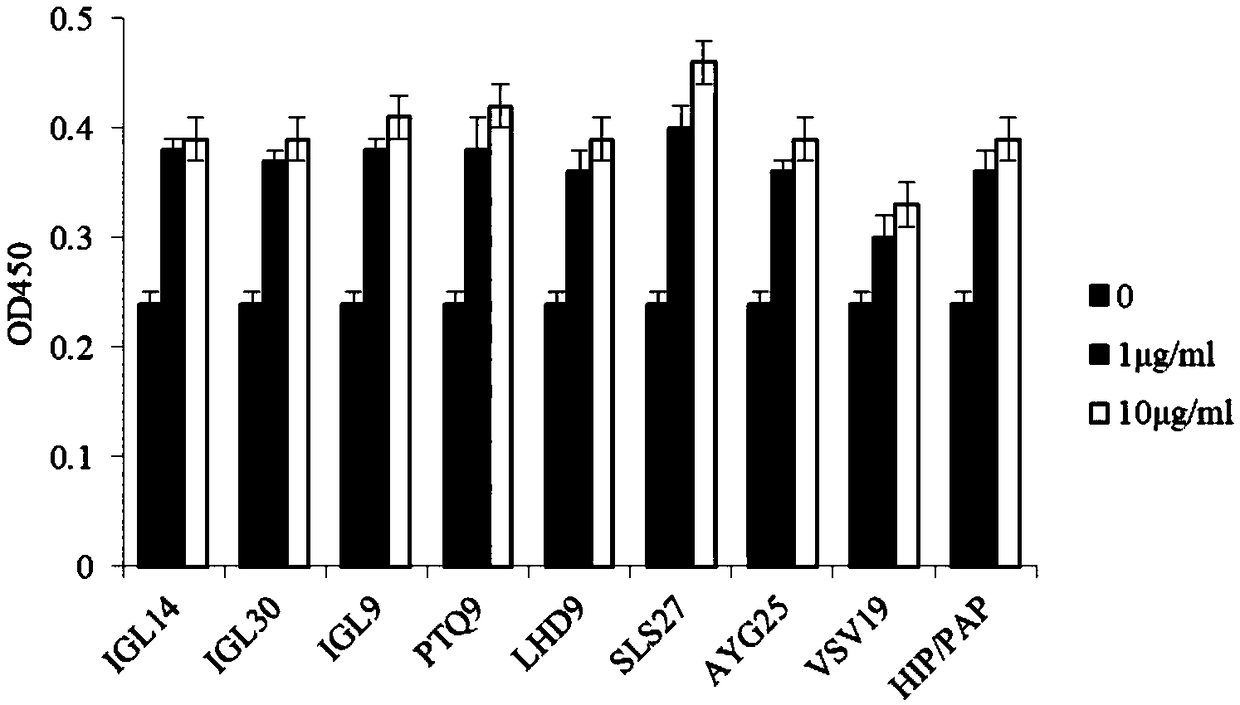Polypeptide capable of promoting hepatocyte proliferation and/or inhibiting hepatocyte apoptosis and application thereof
A liver cell and apoptosis technology, applied in animal cells, vertebrate cells, artificial cell constructs, etc., can solve the problems of complicated purification methods and high production costs, and achieve the effects of low immunogenicity, small molecular weight, and easy synthesis
- Summary
- Abstract
- Description
- Claims
- Application Information
AI Technical Summary
Problems solved by technology
Method used
Image
Examples
Embodiment 2
[0031] Example 2 Detecting the Activity of Promoting Hepatocyte Proliferation in Vitro
[0032] In this example, the human liver cell line HL-7702 was purchased from ATCC.
Embodiment 1
[0033] In this embodiment, the method for detecting the activity of the 6 polypeptides described in Example 1 and HIP / PAP in promoting the proliferation of liver cells in vitro is as follows:
[0034] Take out the frozen HL-7702 cells and thaw them in a water bath at 37°C. Centrifuge at 800 rpm for 5 minutes on a low-speed centrifuge; aspirate the supernatant and resuspend the cells in 1 ml of medium.
[0035] The resuspended cells were transferred to a new culture flask, and an appropriate amount of MEM medium was added. As for CO 2 Incubator culture (cultivation condition 5% CO 2 , saturated humidity, 37°C).
[0036] After the cells grow to 80%, the cells are digested and scattered by blowing and counting, and the cell concentration is adjusted to 1×10 5 cells / ml, added to a 96-well plate, 100 μl per well, that is, 1×10 cells per well 4 indivual.
[0037]After the cells adhered to the wall, different drugs were added for treatment, namely IGL9, PTQ9, LHD9, SLS27, AYG25,...
Embodiment 3
[0041] Example 3 Detecting the Activity of Inhibiting Hepatocyte Apoptosis in Vitro
[0042] In this embodiment, the method for detecting the activity of the 6 polypeptides described in Example 1 and HIP / PAP in vitro inhibiting liver cell apoptosis is as follows:
[0043] Human hepatocytes HL-7702 were spread in 96-well plates, and the cell concentration was 1×10 5 cells / ml, 100 μl per well, that is, 1×10 cells per well 4 indivual.
[0044] Each well was treated with 20ng / mL Act D2 for 30min and 80ng / ml TNF-α for 48h to establish the cell apoptosis model.
[0045] Add corresponding drugs for treatment, respectively IGL9, PTQ9, LHD9, SLS27, AYG25, VSV19, HIP / PAP, the volume of drug addition is 10 μl, and two concentrations of each drug (final concentrations are 1 μg / ml and 10 μg / ml respectively) are added The volume was 10 μl, and the same volume of PBS was used as a negative control.
[0046] After 24 hours of drug treatment, add 100 μl to each well Reagent ( 3 / 7 Assay...
PUM
 Login to View More
Login to View More Abstract
Description
Claims
Application Information
 Login to View More
Login to View More - R&D
- Intellectual Property
- Life Sciences
- Materials
- Tech Scout
- Unparalleled Data Quality
- Higher Quality Content
- 60% Fewer Hallucinations
Browse by: Latest US Patents, China's latest patents, Technical Efficacy Thesaurus, Application Domain, Technology Topic, Popular Technical Reports.
© 2025 PatSnap. All rights reserved.Legal|Privacy policy|Modern Slavery Act Transparency Statement|Sitemap|About US| Contact US: help@patsnap.com



